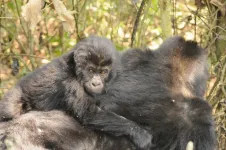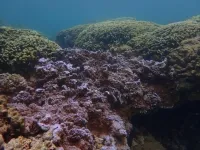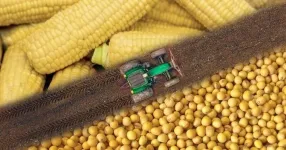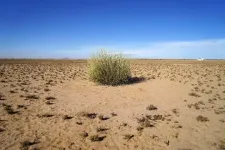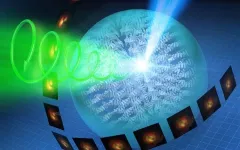(Press-News.org) For nearly half a century, astrophysicists and organic chemists have been on the hunt for the origins of C6H6, the benzene ring - an elegant, hexagonal molecule comprised of 6 carbon and 6 hydrogen atoms.
Astrophysicists say that the benzene ring could be the fundamental building block of polycylic aromatic hydrocarbons or PAHs, the most basic materials formed from the explosion of dying, carbon-rich stars. That swirling mass of matter would eventually give shape to the earliest forms of carbon - precursors to molecules some scientists say are connected to the synthesis of the earliest forms of life on Earth.
Paradoxically, PAHs have a dark side, too. The industrial processes behind crude oil refineries and the inner-workings of gas-powered combustion engines can emit PAHs, which can snowball into toxic air pollutants like soot.
Exactly how the first benzene ring formed from stars in the early universe - and how combustion engines trigger the chemical reaction that alters the benzene ring into soot particle pollutants - have long mystified scientists.
But now, researchers at Lawrence Berkeley National Laboratory (Berkeley Lab), the University of Hawaii at Manoa, and Florida International University have demonstrated the first real-time measurement, using lab-based methods, of unstable particles called free radicals reacting under cosmic conditions, prompting elementary carbon and hydrogen atoms to coalesce into primal benzene rings.
The researchers say that their findings, recently published in the journal Science Advances, are key to understanding how the universe evolved with the growth of carbon compounds. That insight could also help the car industry make cleaner combustion engines.
A type of free radical called the propargyl radical (C3H3) is extremely reactive due to its propensity for losing an electron, and has been implicated in soot formation for decades. Researchers believed that the recombination of two free propargyl radicals, C3H3· + C3H3·, gave rise to the first aromatic ring, benzene.
The current study is the first demonstration of the so-called "radical propargyl self-reaction" under astrochemical and combustion conditions. Using a high-temperature, coin-sized chemical reactor called the "hot nozzle," the researchers simulated the high-pressure, high-temperature environment inside a combustion engine as well as the hydrocarbon-rich atmosphere of Saturn's moon Titan, and observed the formation of isomers - molecules with the same chemical formula but different atomic structures - from two propargyl radicals leading up to the benzene ring.
The hot-nozzle technique, which co-senior author Musahid Ahmed, senior staff scientist in Berkeley Lab's Chemical Sciences Division, adapted 10 years ago at Berkeley Lab's Advanced Light Source (ALS) for synchrotron experiments, relies on vacuum ultraviolet (VUV) spectroscopy to detect individual isomers. The ALS is a type of particle accelerator known as a synchrotron that generates extremely bright beams of light ranging from infrared through X-rays.
The researchers steered the technique to arrest the propargyl radical self-reaction - which unfolds within microseconds - just before larger PAHs and subsequent soot form. The compelling result supports predictions from experiments led by co-senior author Ralf Kaiser, professor of chemistry at the University of Hawaii at Manoa, and quantum chemistry simulations formulated by co-senior author Alexander Mebel, professor of chemistry at Florida International University.
They believe that the finding could one day lead to cleaner combustion engines. Having more efficient gas engines, some analysts say, is still important, because it may take another 25 years before we can replace the entire fleet of gas cars with electric vehicles (EVs). Furthermore, equipping airplanes and the gas-powered component of hybrid plug-in EVs with cleaner combustion engines could help reduce CO2 emissions contributing to climate change.
Ahmed said he plans to extend the methods employed to study PAH growth, and probe other systems of relevance to the DOE mission, such as water desalination and environmental science.
"We'd also like to go and catch a buckyball, C60, one of nature's biggest clues to the secrets behind symmetry," Ahmed said.
Kaiser added that their research could help astronomers plot a carbon map of the universe, and zero in on the cosmic origins behind DNA's carbon frameworks.
INFORMATION:
Co-authors on the paper include Long Zhao at the University of Hawaii at Manoa; Wenchao Lu at Berkeley Lab; and Marsel Zagidullin and Valeriy Azyazov at Samara National Research University in Russia.
The Advanced Light Source is a DOE user facility at Berkeley Lab.
This work was supported by the DOE Office of Science.
Founded in 1931 on the belief that the biggest scientific challenges are best addressed by teams, Lawrence Berkeley National Laboratory and its scientists have been recognized with 14 Nobel Prizes. Today, Berkeley Lab researchers develop sustainable energy and environmental solutions, create useful new materials, advance the frontiers of computing, and probe the mysteries of life, matter, and the universe. Scientists from around the world rely on the Lab's facilities for their own discovery science. Berkeley Lab is a multiprogram national laboratory, managed by the University of California for the U.S. Department of Energy’s Office of Science.
DOE's Office of Science is the single largest supporter of basic research in the physical sciences in the United States, and is working to address some of the most pressing challenges of our time. For more information, please visit energy.gov/science.
New research shows transmission of the virus behind COVID-19 varies seasonally, but warmer conditions are not enough to prevent transmission.
The study, led by Imperial College London researchers and published today in Proceedings of the National Academy of Sciences, is the first to incorporate environmental data into epidemiological models of the transmission of SARS-CoV-2, the virus behind COVID-19.
The team show that temperature and population density are the most important factors determining how easily the virus spreads, but only in the absence of mobility-restricting measures, such as lockdowns.
First author of the study Dr Tom Smith, from the Department of Life Sciences at Imperial, said: "Our results ...
KINSHASA, Democratic Republic of Congo (June 9, 2021) - A new study led by the Wildlife Conservation Society (WCS) has updated the global population estimate for the Critically Endangered Grauer's gorillas (Gorilla beringei graueri) - the world's largest gorilla subspecies- to 6,800 individuals from a previous global estimate of 3,800 individuals. This revised estimate comes from recent field surveys conducted in one of this animal's largest remaining strongholds, in areas that were previously inaccessible for surveys. However, these gorillas continue to be heavily impacted by ongoing insecurity, and by human incursion into their remaining habitat in eastern Democratic Republic of Congo.
Publishing in the American Journal of Primatology, ...
Researchers at Vanderbilt University Medical Center (VUMC) have identified a common mechanism underlying a spectrum of epilepsy syndromes and neurodevelopmental disorders, including autism, that are caused by variations in a gene encoding a vital transporter protein in the brain.
Their findings, reported last month in the journal Brain, suggest that boosting transporter function via genetic or pharmacological means could be beneficial in treating brain disorders linked to these genetic variations.
"This points (to) a clear direction of treating a wide spectrum of neurodevelopmental disorders, from various epilepsy syndromes (and) autism to neurodevelopmental delay and intellectual ...
June 9, 2021 - The first analysis of medical evidence on domestic mass shooters in the U.S. finds that a large majority of perpetrators have psychiatric disorders for which they have received no medication or other treatment, reports a study in the Journal of Clinical Psychopharmacology. The journal is published in the Lippincott portfolio by Wolters Kluwer.
"Without losing sight of the larger perspective that most who are violent are not mentally ill, and most of the mentally ill are not violent, our message is that mental health providers, lawyers, and the public should be made aware that some unmedicated patients do pose an increased risk of violence," according to the report by Ira D. Glick, MD, of Stanford University School of Medicine and colleagues.
In-depth analysis of ...
Smithsonian Conservation Biology Institute scientists are one step closer to understanding why some corals can weather climate change better than others, and the secret could be in a specific protein that produces a natural sunscreen. As their name implies, Hawaiian blue rice corals sport a deep blue pigment, which is created by chromoprotein and filters out harmful ultraviolet (UV) radiation from the sun. Although UV damage may produce long-term impacts to reproduction in many coral species--including brown rice coral--it may not have the same effect on blue rice coral. The findings of this study were published June 9 in ...
From 1980 to 2016, grain production in Brazil increased more than fourfold, and the country now stands as the world's largest soybean exporter and the second largest exporter of corn. The two main drivers of this increase in food production were cropland expansion and double-cropping, harvesting two crops, such as corn and soybeans, from the same field in a single year.
While cropland expansion has long been recognized as one of the drivers behind the increase in Brazil's agricultural output, a new study published in Nature Food quantifies for the first time the impact that double-cropping also ...
The fairy circles of the Namib are one of nature's greatest mysteries. Millions of these circular barren patches extend over vast areas along the margins of the desert in Namibia. In 1979, G.K. Theron published the first research about their origin. His hypothesis was that poisonous substances from Euphorbia damarana leaves induced fairy circles. As part of a new study, scientists from the University of Göttingen and the Gobabeb Namib Research Institute located the original euphorbia plants that were part of Theron's study. Four decades later, the researchers are now able to conclusively disprove Theron's original hypothesis. Their results were published in the journal BMC Ecology and Evolution.
In the late 1970s, South African botanist Theron noticed ...
A University of Oklahoma doctoral student, graduate and undergraduate research assistants, and an associate professor in the Homer L. Dodge Department of Physics and Astronomy in the University of Oklahoma College of Arts and Sciences are lead authors on a paper describing a "changing-look" blazar - a powerful active galactic nucleus powered by supermassive blackhole at the center of a galaxy. The paper is published in The Astrophysical Journal.
Hora D. Mishra, a Ph.D. student, and faculty member Xinyu Dai are lead authors of the paper, along with Christopher Kochanek and Kris Stanek at the Ohio State University and Ben Shappee at the University of Hawaii. The paper represents the findings of researchers from 12 different institutions who participated ...
Tsukuba, Japan - Holographic displays help add a three-dimensional--and thus more life-like--feel to what would otherwise appear as a two-dimensional image. Now, researchers in Japan have tested how this may work on a supramolecular level; such tests could lead to improved displays.
Commonly, one cannot overlay a certain type of molecular component that underlies helically arranged liquid crystals onto their molecular mirror images, much like a person cannot overlay their two hands and have them match up exactly without flipping one over. Molecules with this property are described as "chiral." Some materials make use of the principle of chirality to rotate light in a plane perpendicular to the direction of the light wave, known as circular ...
Researchers from the Singapore University of Technology and Design (SUTD) have developed novel techniques, known as Automated Fibre Embedding (AFE), to produce complex fibre and silicone composite structures for soft robotics applications. Their work was published in IEEE Robotics and Automation Letters.
Many soft robot components, including sensors and actuators, utilise embedded continuous fibres within elastomeric substrates to achieve various functionalities. However, manual embedding of continuous fibres in soft substrates is challenging due to the complexities involved in handling precise layering, and ...

